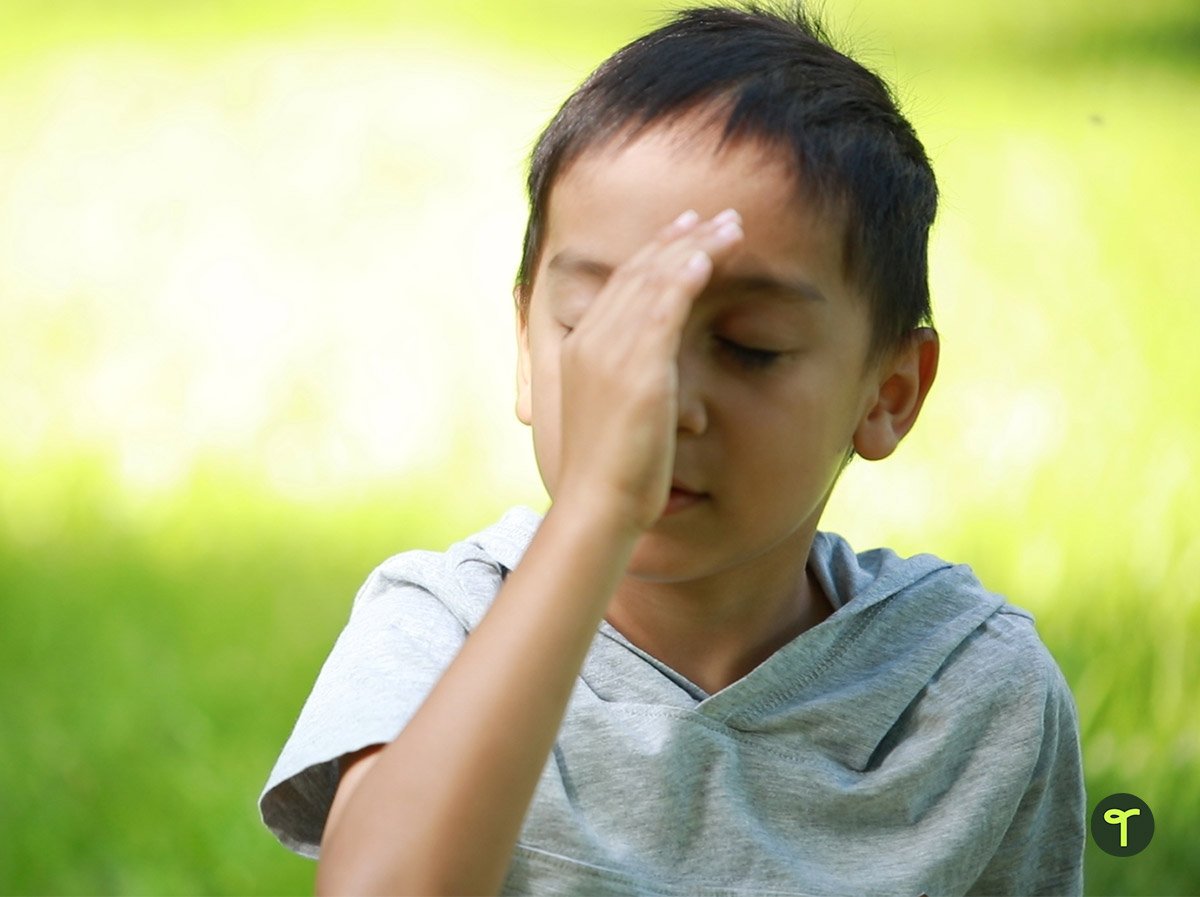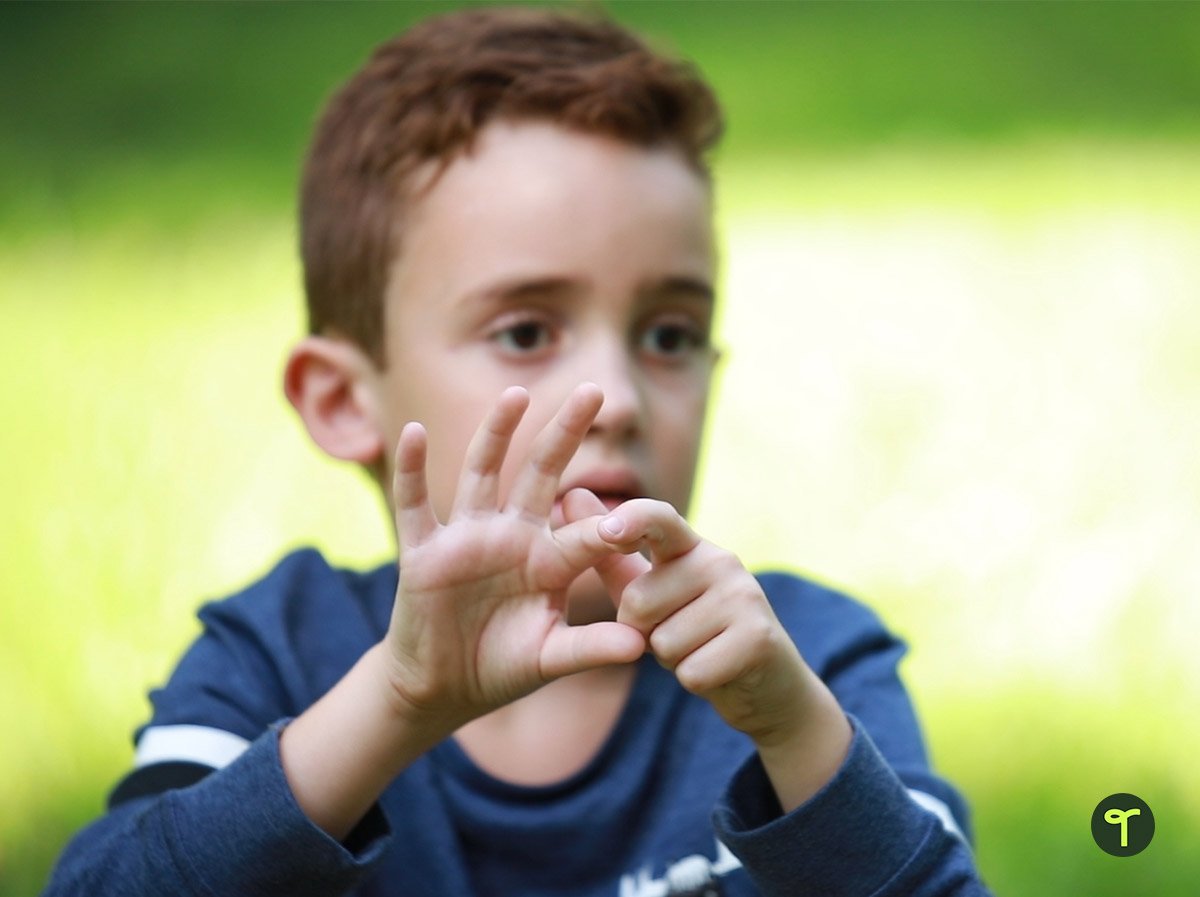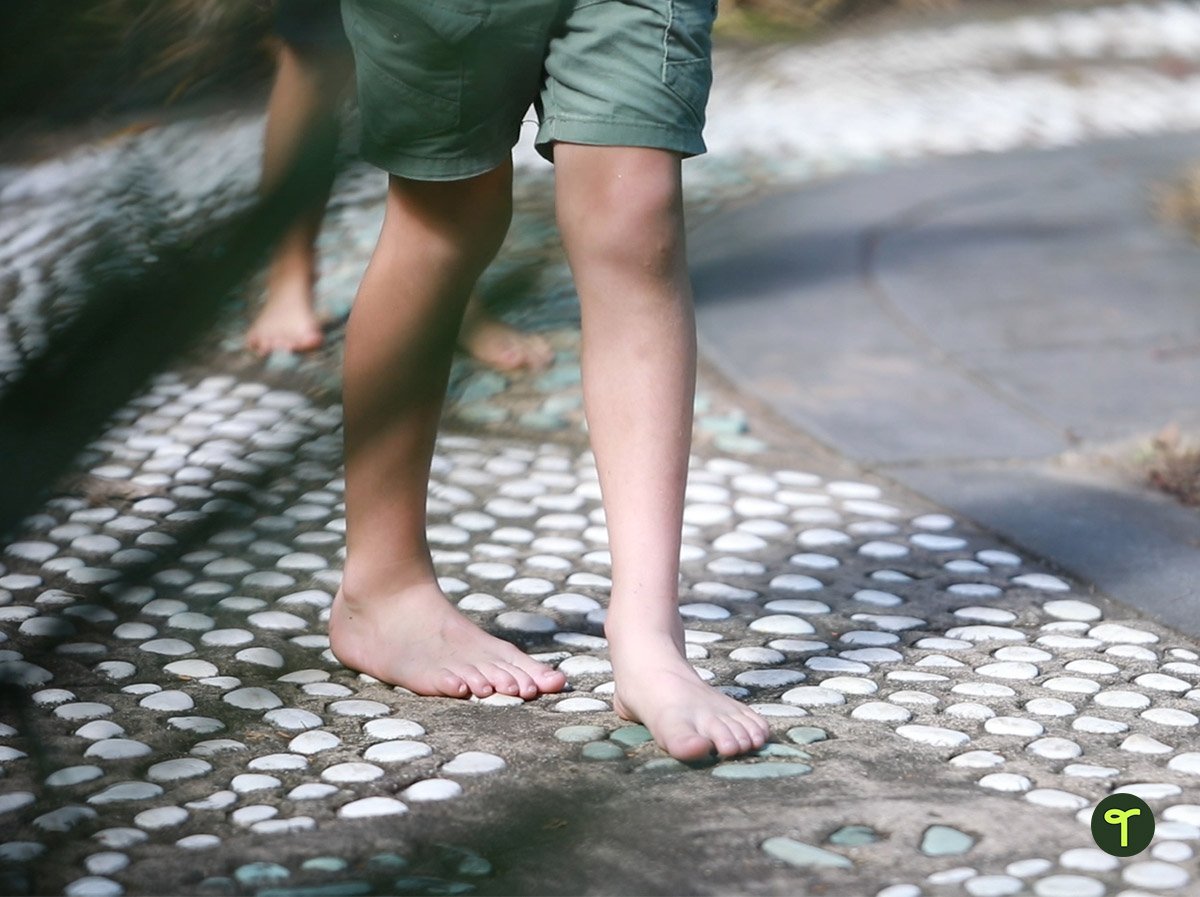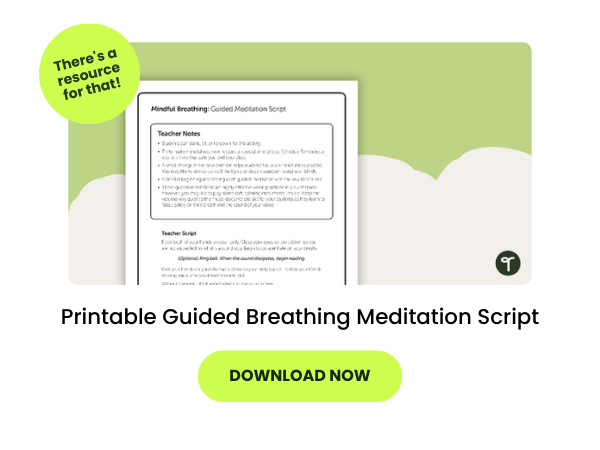The positive benefits of teaching mindfulness activities to children have been proven across a number of studies. Incorporating mindfulness into everyday classroom activities is becoming more and more common. A five- or 10-minute daily mindfulness practice can see students reduce stress and anxiety, increase concentration and engagement, sleep better, improve social skills, and develop problem-solving and decision-making skills.
How Can Kids Practice Mindfulness?
Students walk into our classrooms each day carrying with them their entire experience. Their thoughts and actions are often influenced by their own states of mind, often as much as or even more so than the lessons we’re teaching!
Whether it simply be a rushed morning after a late night, feeling ill-prepared for the big test or dealing with more serious trauma, a child’s stress levels can make it difficult to concentrate and learn.
Including mindfulness in education is a simple practice that provides students with something they can do in those moments of stress, distraction or anger, giving them the tools they need to succeed.
Mindfulness may be defined as purposely paying attention and being ‘in the moment’ and tied to meditation, but that doesn’t mean you need to pull out yoga mats and get the kids on the floor with their eyes closed … unless you want to!
The teachers of Teach Starter have put together this list of mindfulness activities for kids throughout elementary school, all designed to help incorporate mindfulness into the school day in child-appropriate ways that will benefit their social and emotional learning.
Teaching Mindfulness
Before we dive into the actual activities, we need to talk about the act of teaching mindfulness. You may be familiar with the practice already. Then again, you may be starting from scratch! Here are some tips that may help!
- First, develop a personal practice. If you have never practiced mindfulness before, spend a little time practicing the activities yourself before you take them to your classroom. Don’t be intimidated by this step! Smiling Minds is a great free app with kids and adult programs with short guided modules. It might just bring awareness to some of your already mindful practices!
- Be honest with your students about your own level of experience. If mindfulness is new to you too, your students will appreciate knowing that you are learning this together!
- Make mindfulness mini-lessons a special time of day. Make students aware that the 5 or 10 minutes you spend on mindfulness each day is a special time. A visible change in the environment is a good way to do this. You may turn the lights out or begin each of your mindfulness sessions by ringing a little bell.
- Explain what mindfulness is in a simple way. Younger students may understand words like ‘awareness’ or ‘noticing’ when introducing the concept of mindfulness. It is simply being aware of or noticing what is happening in a specific moment. Older students will benefit greatly from exploring how and why mindfulness works.
- Practice naming emotions. Exploring emotions vocabulary and practicing naming and describing emotions and what they feel like in our body should happen alongside your more explicit mindfulness activities. This will help students with their own mindfulness skills as they get better at recognizing and processing their own emotions.
- Acknowledge with your class that you cannot fail at mindfulness. Tell students that their minds will wander during mindfulness activities and that it’s okay! There is no way of ‘failing’ at mindfulness. We notice that our thoughts have wandered in that moment and return our attention to our breath, in whatever our mindful activity may be.
- Be flexible. If your class doesn’t take to a particular activity, take it out of your rotation! There are so many ways to explore mindfulness. Please don’t feel like your mindfulness mini-lessons are a waste of time if things aren’t going well. Next time try an activity that is more suited to the personalities in your class!
- Let go of expectations. Don’t expect a sudden change in your classroom environment after practicing mindfulness briefly. It is a skill that takes time. When it is new to your students, they will need consistent practice and support to get to a place where they call upon their own powers of mindfulness outside of your direct instruction.
- Never use mindfulness practices as a punishment! Gone are the days when sitting in silence is used as a form of punishment for a misbehaving class. Mindfulness practices should always be incorporated into your classroom as positive, skill-building experiences, not reactionary or negative ones.
5-10 Minute Mindfulness Activities for Kids
If you’ve been used to thinking of mindfulness as hours spent in quiet meditation, you may not think primary students — with their short attention spans — are up for the task. Fortunately, you don’t need to spend long on mindfulness for it to be effective. Setting aside just 5 or 10 minutes during the school day is plenty! These activities will all fit into that time frame, from breath awareness activities to mindful coloring.
If you have never practiced mindfulness before you may want to download our Mindfulness Resource Bundle for Teachers.
Explicitly teaching mindful breathing is providing students with a skill that will be with them for life in every situation they will ever encounter. These are the first stop on your students’ journey to mindfulness. Their breath is the one thing that will always be with them.
Mindful Breathing
Students can stand or sit for this activity and be instructed to put their hands on their bellies, then close their eyes or look down at their hands to limit distractions.
- Guide students in taking three slow deep breaths in and out to see if they can feel their hands being moved.
- You can count ‘1, 2, 3’ for each breath in and ‘1, 2, 3’ for each breath out, pausing slightly at the end of each exhale.
- Encourage students to think about how the breath feels, answering the following questions silently, in their minds:
- What is moving your hands? Is it the air filling your lungs?
- Can you feel the air moving in through your nose?
- Can you feel it moving out through your nose?
- Does the air feel a little colder on the way in and warmer on the way out?
- Can you hear your breath?
- What does it sound like?
Pinwheel Breathing— 5-Minute Mindfulness Activity
Students with an object to focus on is a great way to encourage concentration during mindfulness activities for kids. Use pinwheels in conjunction with the mindful breathing exercise above, making the pinwheel spin with every exhale.
Print a DIY pinwheel template that students can decorate themselves before putting it together and using for their breathing exercises!

Belly Buddies — 10-Minute Mindfulness Activity
Ask students to bring in a small stuffed toy, or provide a class set of small, lightweight objects such as small bean bags or wooden blocks for ‘belly buddies.’ In this mindful activity, students lay on their backs and place the toy or object on top of their belly buttons.
Then you can take students through the guided breathing activity above, asking them to watch the object as it moves up and down with their breath.
Pair this with a mindful breathing video that can be played to help students relax!
Shark Fin — 2-Minute Mindfulness Activity
Coined by former Mindful Schools co-founder Laurie Gossman and Mr. Musumeci’s Grade 5 class of the book “Master of Mindfulness: How to Be Your Own Superhero in Times of Stress” fame, the Shark Fin is a fantastic tool that you can use during any quick moment in your day. It will help to calm your class or individual students when their minds and bodies may be fighting against them.
- Place the side of your hand on your forehead, with your palm facing out to the side.
- Close your eyes.
- Slide your hand down your face in front of your nose.
- Say ‘shhh’ as you slide your hand down your face
- If you are sitting down, you do the 5 Ss while you move your hand: Sit up straight, sit still, sit silently, soft breathing, shut eyes.
- If you are standing do the same, but you are standing straight, still, silently, using soft breathing, and shut eyes while you move your hand down your face.

Breathing Hands — 2-Minute Mindfulness Activity
- Spread one hand out like a star.
- Use the index finger on your other hand to trace the outline of your star hand.
- Take a deep breath in as you move to the top of your thumb.
- Breathe out as you move down between your thumb and first finger.
- Take another breath in as you move to the top of your first finger.
- Breathe out as you move down between your first and second finger.
- Repeat until you have taken five slow, deep breaths.

Back-to-Back Breathing
This activity uses the basic script from the first mindful breathing activity, but students work with a classmate, increasing empathy as part of their mindfulness practice.
Here’s how it works:
- Sitting tall, with their back resting against their partner’s back, begin the mindful breathing from activity.
- Encourage students to notice their partner’s breath. Is it shallow or deep? Fast or slow? Can they feel their partner’s back moving as they breathe
- After a little while, students may find that their breath falls into sync with their partner, or it may not! These are all talking points for bringing awareness to the breath, in the present moment.
Teach Starter Teacher Tip: You could incorporate your Mindfulness Pinwheels into this activity too!
Body Scan
This is a fantastic activity that students can “take home” with them. Doing a body scan to help relax before sleep can be particularly useful. Download our printable Body Scan Guided Meditation Script to use with your class.
Here’s how it works:
- Students lay on the floor, with their eyes closed if they are comfortable (or they may prefer to look at the ceiling).
- Encourage students to pay attention to their feet for 5 or 10 seconds.
- Move on to their toes, then ankles, then calves and knees. Continue body part by body part until you reach the head.
- Question how each part of the body feels to bring students’ awareness to their body in the moment.
- If there is tightness or stress, imagine breathing the stress out of that part of the body with each exhale.
Here are some questions to ask during a body scan:
- How does this body part feel?
- Is it cold or warm?
- Does it feel tight or relaxed?
- Is all or part of that body part touching the floor?
- Or clothing?
- What does that feel like?
Practising Active Mindfulness
Mindful breathing is arguably the most important skill you can teach your students when it comes to mindfulness. However, being able to incorporate into everyday activities the calm and focused state of mind that the breathing activities practise can be viewed as a more tangible end goal.
The following active practices help hone mindful action skills. Some students who struggle with the still mindfulness activities may be more likely to feel successful during active practices.
Spidey Senses
Spidey Senses is a fun way to frame a traditional mindfulness exercise focusing on the senses. Ask students to switch their senses up to a superpower level, just like Spiderman, and walk them through a series of senses-focused questions.
- What can they hear?
- What can they see?
- What can they taste?
- What can they smell?
- What can they feel?
Guide students as they stay in this Spidey state for 2-3 minutes.
The five senses slide deck and graphic organizer can be useful resources for teaching the senses to younger students.
Mindful Steps
This activity is best completed outdoors; if suitable, students may be given permission to walk barefoot. Each student selects a small area where they can walk in a line for about 5 or 6 steps and back then back to where they started without getting into another person’s way.
- Begin this practice with three deep breaths or the Shark Fin activity from above.
- Take 5 or 6 steps in one direction, turn slowly, and then take 5 or 6 steps back to where you started.
- While walking, students bring their awareness to their breath and their body. Encourage them not to change the way they walk but instead to notice how the body naturally moves.
Some questions you can ask are:
- What does the ground feel like under your feet?
- Which part of your foot touches the ground first when you take a step?
- Does your body feel heavy or light today?
- Are you slouching when you walk?
- Is your back up quite straight?

Sense Countdown
A great one for older students, this is an extension of the Spidey Senses activity that can be used to help calm a busy mind and bring awareness to the present moment.
Think of:
- 5 things you can see
- 4 things you can touch
- 3 things you can hear
- 2 things you can smell
- 1 thing you can taste
Mindful Colouring
While some students might struggle at first with other more active mindfulness practices, mindfulness coloring, by its very nature, helps even the most active and busy child (and adult!) slow down a little.
Art Techniques
Mindful coloring pages don’t just have to be for coloring in. Why not use them as an opportunity to teach your students about color, pattern or shading? The different sections in each picture allow students to practice different techniques.
Here are some ideas they can try:
- Color the animal varying shades of warm or cool colors.
- Use a different pattern technique — for example, dots or stripes — in each section.
- Practice shading by pressing firmly or softly to create a 3D effect in different sections.
Make It a Whole Class Activity
If you really want some mindful coloring that can bring your whole class together, make it a class mural!
We’ve printed this amazing Cockatoo Mindful Coloring Sheet on large paper for the whole office to add to on their own time.
Whether it’s a calm-down area, a fast-finishers activity or even just a place a student can go when they feel like they need a moment of mindfulness, displaying a giant printout of one of these wonderful mindful coloring pages will lift your students up and bring some color to your classroom.
Writing Prompts
Why not use your class’s beautiful creations as a prompt for a writing task?
Writing, such as poetry or narratives, can be built around each of the unique animals on these pages. Use your students’ images as the main character and have them complete a simple storyboard template about their creature.








Comments